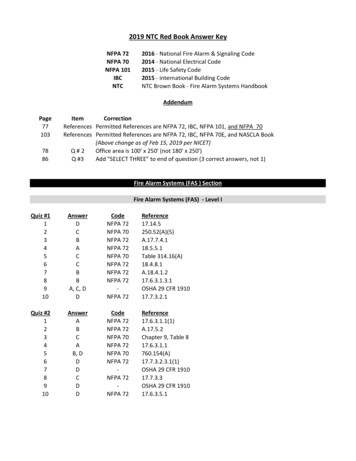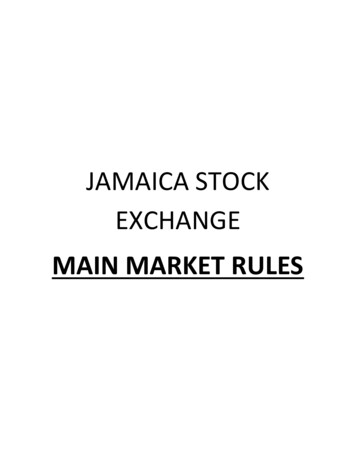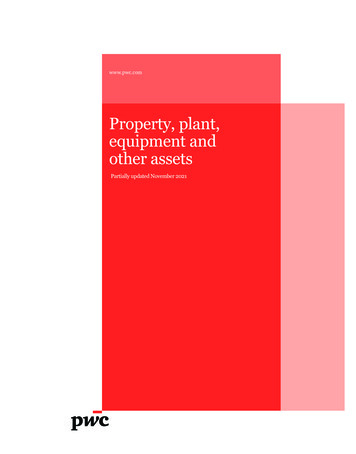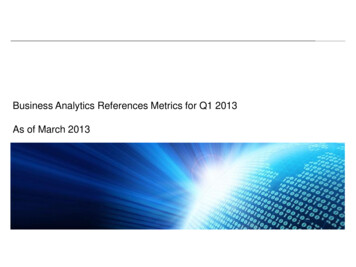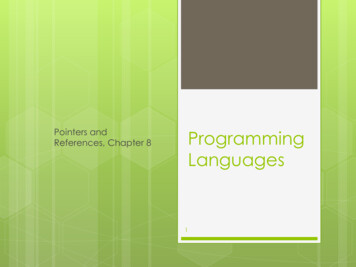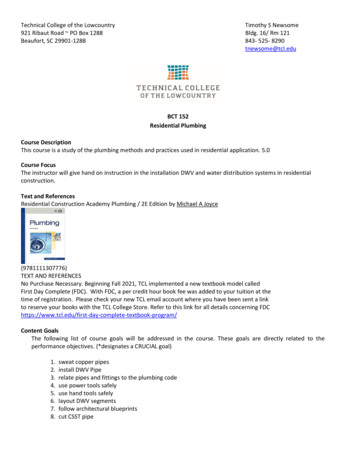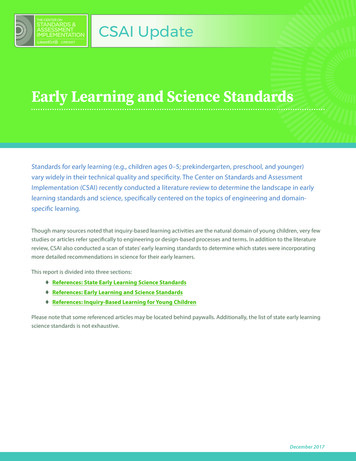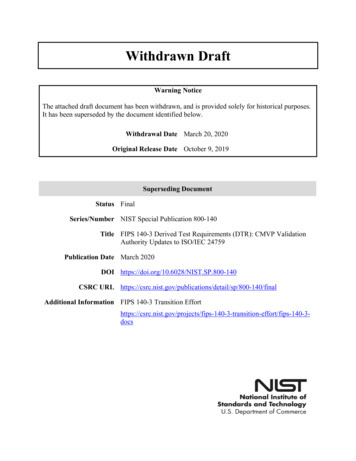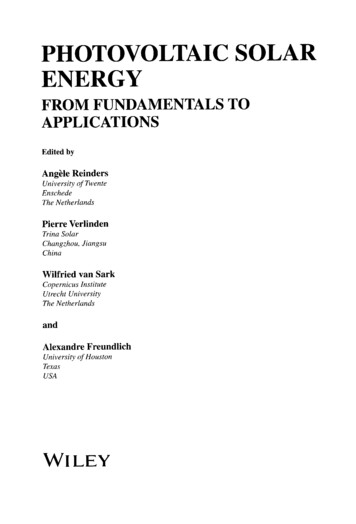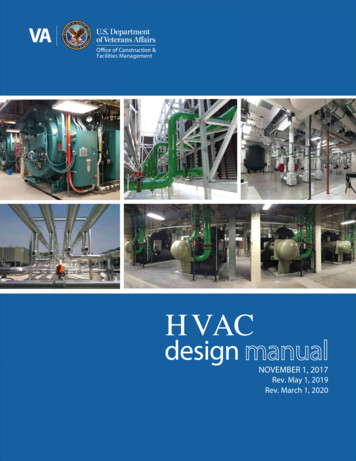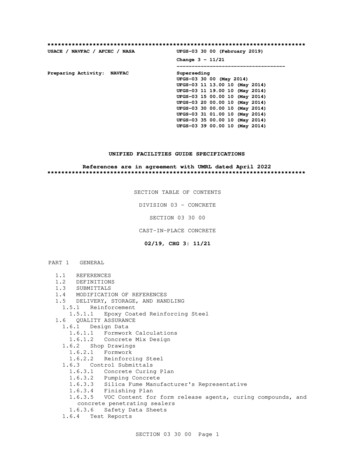
Transcription
************************USACE / NAVFAC / AFCEC / NASAPreparing Activity:NAVFACUFGS-03 30 00 (February 2019)Change 3 - gUFGS-03 30 00 (May 2014)UFGS-03 11 13.00 10 (May 2014)UFGS-03 11 19.00 10 (May 2014)UFGS-03 15 00.00 10 (May 2014)UFGS-03 20 00.00 10 (May 2014)UFGS-03 30 00.00 10 (May 2014)UFGS-03 31 01.00 10 (May 2014)UFGS-03 35 00.00 10 (May 2014)UFGS-03 39 00.00 10 (May 2014)UNIFIED FACILITIES GUIDE SPECIFICATIONSReferences are in agreement with UMRL dated April ****************************SECTION TABLE OF CONTENTSDIVISION 03 - CONCRETESECTION 03 30 00CAST-IN-PLACE CONCRETE02/19, CHG 3: 11/21PART 4MODIFICATION OF REFERENCES1.5DELIVERY, STORAGE, AND HANDLING1.5.1Reinforcement1.5.1.1Epoxy Coated Reinforcing Steel1.6QUALITY ASSURANCE1.6.1Design Data1.6.1.1Formwork Calculations1.6.1.2Concrete Mix Design1.6.2Shop Drawings1.6.2.1Formwork1.6.2.2Reinforcing Steel1.6.3Control Submittals1.6.3.1Concrete Curing Plan1.6.3.2Pumping Concrete1.6.3.3Silica Fume Manufacturer's Representative1.6.3.4Finishing Plan1.6.3.5VOC Content for form release agents, curing compounds, andconcrete penetrating sealers1.6.3.6Safety Data Sheets1.6.4Test ReportsSECTION 03 30 00Page 1
1.6.4.1Fly Ash and Pozzolan1.6.4.2Slag Cement1.6.4.3Aggregates1.6.4.4Fiber-Reinforced Concrete1.6.5Field Samples1.6.5.1Slab Finish Sample1.6.5.2Surface Finish Samples1.6.6Quality Control Plan1.6.7Quality Control Personnel Certifications1.6.7.1Quality Manager Qualifications1.6.7.2Field Testing Technician and Testing Agency1.6.8Laboratory Qualifications for Concrete Qualification Testing1.6.9Laboratory Accreditation1.7ENVIRONMENTAL REQUIREMENTS1.7.1Submittals for Environmental Performance1.8SUSTAINABLE DESIGN REQUIREMENTS1.8.1Local/Regional Materials1.8.2Forest Stewardship Council (FSC) Certification1.9QUALIFICATIONS FOR WELDING WORKPART 2PRODUCTS2.1FORMWORK MATERIALS2.1.1Wood Forms2.1.1.1Concrete Form Plywood (Standard Rough)2.1.1.2Overlaid Concrete Form Plywood (Standard Smooth)2.1.2Plastic Forms2.1.3Carton Forms2.1.4Steel Forms2.2FORMWORK ACCESSORIES2.2.1Form Ties2.2.2Waterstops2.2.2.1PVC Waterstop2.2.2.2Rubber Waterstop2.2.2.3Thermoplastic Elastomeric Rubber Waterstop2.2.2.4Hydrophilic Waterstop2.2.3Biodegradable Form Release Agent2.2.4Chamfer Materials2.2.5Construction and movement joints2.2.6Other Embedded items2.3CONCRETE MATERIALS2.3.1Cementitious Materials2.3.1.1Portland Cement2.3.1.2Blended Cements2.3.1.3Fly Ash2.3.1.4Slag Cement2.3.1.5Silica Fume2.3.1.6Other Supplementary Cementitious ght Aggregate2.3.3.2Lightweight Aggregate2.3.3.3Recycled Aggregate Materials2.3.4Admixtures2.4MISCELLANEOUS MATERIALS2.4.1Concrete Curing Materials2.4.2Nonshrink Grout2.4.3Floor Finish Materials2.4.3.1Liquid Chemical Floor Hardeners and SealersSECTION 03 30 00Page 2
2.4.3.2Abrasive Aggregate for Nonslip Aggregate Finish2.4.3.3Dry Materials for Colored Wear-Resistant Finish2.4.3.4Aggregate for Heavy-Duty Wear-Resistant Finish2.4.3.5Aggregate for Heavy-Duty Floor Topping2.4.4Expansion/Contraction Joint Filler2.4.5Joint Sealants2.4.5.1Horizontal Surfaces, 3 Percent Slope, Maximum2.4.5.2Vertical Surfaces Greater Than 3 Percent Slope2.4.5.3Preformed Polychloroprene Elastomeric Type2.4.5.4Lubricant for Preformed Compression Seals2.4.6Vapor Retarder [and Vapor Barrier]2.4.7Dovetail Anchor Slot2.5CONCRETE MIX DESIGN2.5.1Properties and Requirements2.5.2Durability2.5.2.1Alkali-Aggregate Reaction2.5.2.2Freezing and Thawing Resistance2.5.2.3Corrosion and Chloride Content2.5.2.4Sulfate Resistance2.5.2.5Concrete Temperature2.5.2.6Concrete permeability2.5.3Contractor's Option for Material Only2.5.4Trial Mixtures2.5.5Ready-Mix Concrete2.6REINFORCEMENT2.6.1Reinforcing Bars2.6.1.1Galvanized Reinforcing Bars2.6.1.2Epoxy-Coated Reinforcing Bars2.6.1.3Dual-coated Reinforcing Bars2.6.1.4Stainless Steel Reinforcing Bars2.6.1.5Headed Reinforcing Bars2.6.1.6Bar Mats2.6.1.7Headed Shear Stud Reinforcement2.6.2Mechanical Reinforcing Bar Connectors2.6.3Wire2.6.4Welded wire reinforcement2.6.5Reinforcing Bar Supports2.6.6Reinforcing Fibers2.6.6.1Synthetic Fibers2.6.6.2Steel Fibers2.6.7Dowels for Load Transfer in Floors2.6.8WeldingPART 3.2.2Subgrade Under Foundations and Footings3.2.3Subgrade Under Slabs on Ground3.2.4Edge Forms and Screed Strips for Slabs3.2.5Reinforcement and Other Embedded .3.4Forms for Standard Rough Form Finish3.3.5Forms for Standard Smooth Form Finish3.3.6Form TiesSECTION 03 30 00Page 3
3.3.7Forms for Concrete Pan Joist Construction3.3.8Tolerances for Form Construction3.3.9Removal of Forms and Supports3.3.10Strength of Concrete Required for Removal of Formwork3.4WATERSTOP INSTALLATION AND SPLICES3.4.1PVC Waterstop3.4.2Rubber Waterstop3.4.3Thermoplastic Elastomeric Rubber Waterstop3.4.4Hydrophilic Waterstop3.5PLACING REINFORCEMENT AND MISCELLANEOUS MATERIALS3.5.1General3.5.2Vapor Retarder [and Vapor Barrier]3.5.3Perimeter Insulation3.5.4Reinforcement Supports3.5.5Epoxy Coated Reinforcing3.5.5.1Epoxy Coated Reinforcing Steel Placement and Coating Repair3.5.6Splicing3.5.7Future Bonding3.5.8Setting Miscellaneous Material3.5.9Fabrication3.5.10Placing Reinforcement3.5.11Spacing of Reinforcing Bars3.5.12Concrete Protection for Reinforcement3.5.13Welding3.6BATCHING, MEASURING, MIXING, AND TRANSPORTING 3.7PLACING CONCRETE3.7.1Footing Placement3.7.2Pumping3.7.2.1Pumping Lightweight Concrete3.7.3Cold Weather3.7.4Hot Weather3.7.5Bonding3.8WASTE MANAGEMENT3.8.1Mixing Equipment3.8.2Hardened, Cured Waste Concrete3.8.3Reinforcing Steel3.8.4Other Waste3.9SURFACE FINISHES EXCEPT FLOOR, SLAB, AND PAVEMENT FINISHES3.9.1Defects3.9.2Not Against Forms (Top of Walls)3.9.3Formed Surfaces3.9.3.1Tolerances3.9.3.2As-Cast Rough Form3.9.3.3Standard Smooth Finish3.9.4[Smooth-Rubbed][Grout-Cleaned Rubbed][Cork-Floated][ExposedAggregate] Finish3.10FLOOR, SLAB, AND PAVEMENT FINISHES AND MISCELLANEOUS loated3.10.1.3Concrete Containing Silica Fume3.10.1.4Steel Troweled3.10.1.5Nonslip ete Toppings PlacementSECTION 03 30 00Page 4
3.10.1.9Chemical-Hardener Treatment3.10.1.10Colored Wear-Resistant Finish3.10.1.11Heavy-Duty Wear-Resistant Finish3.10.2Flat Floor Finishes3.10.2.1Measurement of Floor Tolerances3.10.2.2Remedies for Out of Tolerance Work3.10.3Concrete Walks3.10.4Pits and Trenches3.10.5Curbs[ and Gutters]3.10.6Splash Blocks3.11JOINTS3.11.1Construction Joints3.11.1.1Maximum Allowable Construction Joint Spacing3.11.1.2Construction Joints for Constructability Purposes3.11.2Isolation Joints in Slabs on Ground3.11.3Contraction Joints in Slabs on Ground3.11.4Sealing Joints in Slabs on Ground3.12CONCRETE FLOOR TOPPING3.12.1Standard Floor Topping3.12.1.1Preparations Prior to -Duty Floor Topping3.12.2.1Heavy-duty Topping Mixture3.12.2.2Base Slab3.12.2.3Placing3.12.2.4Finishing3.13CURING AND PROTECTION3.13.1Requirements for Type III, High-Early-Strength Portland Cement3.13.2Curing Periods3.13.3Curing Formed Surfaces3.13.4Curing Unformed Surfaces3.13.5Temperature of Concrete During Curing3.13.6Protection from Mechanical Injury3.13.7Protection After Curing3.14FIELD QUALITY CONTROL3.14.1Aggregate Testing3.14.1.1Fine Aggregate3.14.1.2Coarse Aggregate3.14.2Concrete Sampling3.14.3Concrete Testing3.14.3.1Slump Tests3.14.3.2Temperature Tests3.14.3.3Compressive Strength Tests3.14.3.4Air Content3.14.3.5Unit Weight of Structural Concrete3.14.3.6Chloride Ion Concentration3.14.3.7Strength of Concrete Structure3.14.3.8Non-Conforming Materials3.14.3.9Testing Concrete Structure for Strength3.15REPAIR, REHABILITATION AND REMOVAL3.15.1Crack Repair3.15.2Repair of Weak Surfaces3.15.3Failure of Quality Assurance Test Results-- End of Section Table of Contents --SECTION 03 30 00Page 5
************************USACE / NAVFAC / AFCEC / NASAPreparing Activity:UFGS-03 30 00 (February 2019)Change 3 - gUFGS-03 30 00 (May 2014)UFGS-03 11 13.00 10 (May 2014)UFGS-03 11 19.00 10 (May 2014)UFGS-03 15 00.00 10 (May 2014)UFGS-03 20 00.00 10 (May 2014)UFGS-03 30 00.00 10 (May 2014)UFGS-03 31 01.00 10 (May 2014)UFGS-03 35 00.00 10 (May 2014)UFGS-03 39 00.00 10 (May 2014)NAVFACUNIFIED FACILITIES GUIDE SPECIFICATIONSReferences are in agreement with UMRL dated April ****************************SECTION 03 30 00CAST-IN-PLACE CONCRETE02/19, CHG 3: *****************************NOTE: This guide specification covers therequirements for cast-in-place concrete not exposedto a marine or high chloride environment. Forconcrete exposed to a marine or high chlorideenvironment, use Section 03 31 30 MARINE CONCRETE.Adhere to UFC 1-300-02 Unified Facilities GuideSpecifications (UFGS) Format Standard when editingthis guide specification or preparing new projectspecification sections. Edit this guidespecification for project specific requirements byadding, deleting, or revising text. For bracketeditems, choose applicable item(s) or insertappropriate information.Remove information and requirements not required inrespective project, whether or not brackets arepresent.Comments, suggestions and recommended changes forthis guide specification are welcome and should besubmitted as a Criteria Change Request ****NOTE: Show the following information on the projectdrawings:1.Loading assumptions.SECTION 03 30 00Page 6
2. Assumed temperature range when temperaturestresses are a factor in design.3. Material strengths used in design for eachelement, f'c.4. Yield strength of reinforcement required 420 MPa60,000 psi or other grades available.5. Details of concrete sections, showingdimensions, reinforcement cover, and required camber.6. Locations where structural lightweight concreteor lightweight insulation or fill concrete are used.7. Details which require a depressed structuralslab for static-disseminating and spark-resistanttile, terrazzo, or other floor finishes in order toprovide finished surfaces at the same elevations.8. Indicate the locations in the finishedstructure, when exposed concrete surfaces arespecified. Indicate the type and location, if otherthan cast finish is *********************************PART *********************************************NOTE: This paragraph is used to list thepublications cited in the text of the guidespecification. The publications are referred to inthe text by basic designation only and listed inthis paragraph by organization, designation, date,and title.Use the Reference Wizard's Check Reference featurewhen you add a Reference Identifier (RID) outside ofthe Section's Reference Article to automaticallyplace the reference in the Reference Article. Alsouse the Reference Wizard's Check Reference featureto update the issue dates.References not used in the text will automaticallybe deleted from this section of the projectspecification when you choose to reconcilereferences in the publish print ********************************The publications listed below form a part of this specification to theextent referenced. The publications are referred to within the text bythe basic designation only.AMERICAN CONCRETE INSTITUTE (ACI)ACI 117(2010; Errata 2011) Specifications forTolerances for Concrete Construction andSECTION 03 30 00Page 7
Materials and CommentaryACI 121R(2008) Guide for Concrete ConstructionQuality Systems in Conformance with ISO9001ACI 213R(2014; E2017) Guide for StructuralLightweight-Aggregate ConcreteACI 301(2016) Specifications for StructuralConcreteACI 302.1R(2015) Guide for Concrete Floor and SlabConstructionACI 304.2R(2017) Guide to Placing Concrete byPumping MethodsACI 304R(2000; R 2009) Guide for Measuring,Mixing, Transporting, and Placing ConcreteACI 305.1(2014) Specification for Hot WeatherConcretingACI 305R(2020) Guide to Hot Weather ConcretingACI 306.1(1990; R 2002) Standard Specification forCold Weather ConcretingACI 306R(2016) Guide to Cold Weather ConcretingACI 308.1(2011) Specification for Curing ConcreteACI 347R(2014; Errata 1 2017) Guide to Formworkfor ConcreteACI SP-2(2007; Abstract: 10th Edition) ACI Manualof Concrete InspectionACI SP-15(2011) Field Reference Manual: StandardSpecifications for Structural Concrete ACI301-05 with Selected ACI ReferencesAMERICAN HARDBOARD ASSOCIATION (AHA)AHA A135.4(1995; R 2004) Basic HardboardAMERICAN WELDING SOCIETY (AWS)AWS D1.4/D1.4M(2011) Structural Welding Code Reinforcing SteelASTM INTERNATIONAL (ASTM)ASTM A36/A36M(2019) Standard Specification for CarbonStructural SteelASTM A53/A53M(2020) Standard Specification for Pipe,Steel, Black and Hot-Dipped, Zinc-Coated,SECTION 03 30 00Page 8
Welded and SeamlessASTM A184/A184M(2019) Standard Specification for WeldedDeformed Steel Bar Mats for ConcreteReinforcementASTM A615/A615M(2020) Standard Specification for Deformedand Plain Carbon-Steel Bars for ConcreteReinforcementASTM A706/A706M(2016) Standard Specification forLow-Alloy Steel Deformed and Plain Barsfor Concrete ReinforcementASTM A767/A767M(2016) Standard Specification forZinc-Coated (Galvanized) Steel Bars forConcrete ReinforcementASTM A775/A775M(2017) Standard Specification forEpoxy-Coated Steel Reinforcing BarsASTM A780/A780M(2020) Standard Practice for Repair ofDamaged and Uncoated Areas of Hot-DipGalvanized CoatingsASTM A820/A820M(2016) Standard Specification for SteelFibers for Fiber-Reinforced ConcreteASTM A884/A884M(2019) Standard Specification forEpoxy-Coated Steel Wire and Welded WireReinforcementASTM A934/A934M(2016) Standard Specification forEpoxy-Coated Prefabricated SteelReinforcing BarsASTM A955/A955M(2020c) Standard Specification forDeformed and Plain Stainless-Steel Barsfor Concrete ReinforcementASTM A970/A970M(2018) Standard Specification for HeadedSteel Bars for Concrete ReinforcementASTM A996/A996M(2016) Standard Specification forRail-Steel and Axle-Steel Deformed Barsfor Concrete ReinforcementASTM A1022/A1022M(2016b) Standard Specification forDeformed and Plain Stainless Steel Wireand Welded Wire for Concrete ReinforcementASTM A1044/A1044M(2016a) Standard Specification for SteelStud Assemblies for Shear Reinforcement ofConcreteASTM A1055/A1055M(2016) Standard Specification for Zinc andEpoxy Dual Coated Steel Reinforcing BarsASTM A1060/A1060M(2016b) Standard Specification forSECTION 03 30 00Page 9
Zinc-Coated (Galvanized) Steel Welded WireReinforcement, Plain and Deformed, forConcreteASTM A1064/A1064M(2017) Standard Specification forCarbon-Steel Wire and Welded WireReinforcement, Plain and Deformed, forConcreteASTM C31/C31M(2021a) Standard Practice for Making andCuring Concrete Test Specimens in the FieldASTM C33/C33M(2018) Standard Specification for ConcreteAggregatesASTM C39/C39M(2021) Standard Test Method forCompressive Strength of CylindricalConcrete SpecimensASTM C42/C42M(2020) Standard Test Method for Obtainingand Testing Drilled Cores and Sawed Beamsof ConcreteASTM C78/C78M(2021) Standard Test Method for FlexuralStrength of Concrete (Using Simple Beamwith Third-Point Loading)ASTM C94/C94M(2021b) Standard Specification forReady-Mixed ConcreteASTM C136/C136M(2019) Standard Test Method for SieveAnalysis of Fine and Coarse AggregatesASTM C138/C138M(2017a) Standard Test Method for Density(Unit Weight), Yield, and Air Content(Gravimetric) of ConcreteASTM C143/C143M(2020) Standard Test Method for Slump ofHydraulic-Cement ConcreteASTM C150/C150M(2021) Standard Specification for PortlandCementASTM C172/C172M(2017) Standard Practice for SamplingFreshly Mixed ConcreteASTM C173/C173M(2016) Standard Test Method for AirContent of Freshly Mixed Concrete by theVolumetric MethodASTM C231/C231M(2017a) Standard Test Method for AirContent of Freshly Mixed Concrete by thePressure MethodASTM C260/C260M(2010a; R 2016) Standard Specification forAir-Entraining Admixtures for ConcreteASTM C311/C311M(2022) Standard Test Methods for Samplingand Testing Fly Ash or Natural PozzolansSECTION 03 30 00Page 10
for Use in Portland-Cement ConcreteASTM C330/C330M(2017a) Standard Specification forLightweight Aggregates for StructuralConcreteASTM C494/C494M(2019) Standard Specification for ChemicalAdmixtures for ConcreteASTM C567/C567M(2019) Determining Density of StructuralLightweight ConcreteASTM C595/C595M(2021) Standard Specification for BlendedHydraulic CementsASTM C618(2019) Standard Specification for Coal FlyAsh and Raw or Calcined Natural Pozzolanfor Use in ConcreteASTM C803/C803M(2018) Standard Test Method forPenetration Resistance of Hardened ConcreteASTM C845/C845M(2018) Standard Specification forExpansive Hydraulic CementASTM C873/C873M(2015) Standard Test Method forCompressive Strength of Concrete CylindersCast in Place in Cylindrical MoldsASTM C900(2015) Standard Test Method for PulloutStrength of Hardened ConcreteASTM C920(2018) Standard Specification forElastomeric Joint SealantsASTM C989/C989M(2018a) Standard Specification for SlagCement for Use in Concrete and MortarsASTM C1012/C1012M(2018b) Standard Test Method for LengthChange of Hydraulic-Cement Mortars Exposedto a Sulfate SolutionASTM C1017/C1017M(2013; E 2015) Standard Specification forChemical Admixtures for Use in ProducingFlowing ConcreteASTM C1074(2019) Standard Practice for EstimatingConcrete Strength by the Maturity MethodASTM C1077(2017) Standard Practice for AgenciesTesting Concrete and Concrete Aggregatesfor Use in Construction and Criteria forTesting Agency EvaluationASTM C1107/C1107M(2020) Standard Specification for PackagedDry, Hydraulic-Cement Grout (Nonshrink)ASTM C1116/C1116M(2010a; R 2015) Standard Specification forFiber-Reinforced ConcreteSECTION 03 30 00Page 11
ASTM C1157/C1157M(2020a) Standard Performance Specificationfor Hydraulic CementASTM C1218/C1218M(2020c) Standard Test Method forWater-Soluble Chloride in Mortar andConcreteASTM C1240(2020) Standard Specification for SilicaFume Used in Cementitious MixturesASTM C1260(2021) Standard Test Method for PotentialAlkali Reactivity of Aggregates(Mortar-Bar Method)ASTM C1293(2008; R 2015) Standard Test Method forDetermination of Length Change of ConcreteDue to Alkali-Silica ReactionASTM C1567(2021) Standard Test Method for PotentialAlkali-Silica Reactivity of Combinationsof Cementitious Materials and Aggregate(Accelerated Mortar-Bar Method)ASTM C1602/C1602M(2018) Standard Specification for MixingWater Used in Production of HydraulicCement ConcreteASTM C1778(2016) Standard Guide for Reducing theRisk of Deleterious Alkali-AggregateReaction in ConcreteASTM D412(2016) Standard Test Methods forVulcanized Rubber and ThermoplasticElastomers - TensionASTM D471(2016a) Standard Test Method for RubberProperty - Effect of LiquidsASTM D1751(2018) Standard Specification forPreformed Expansion Joint Filler forConcrete Paving and StructuralConstruction (Nonextruding and ResilientBituminous Types)ASTM D1752(2018) Standard Specification forPreformed Sponge Rubber, Cork and RecycledPVC Expansion Joint Fillers for ConcretePaving and Structural ConstructionASTM D2628(1991; R 2016) Standard Specification forPreformed Polychloroprene ElastomericJoint Seals for Concrete PavementsASTM D2835(1989; R 2017) Standard Specification forLubricant for Installation of PreformedCompression Seals in Concrete PavementsASTM D3042(2017) Standard Test Method for InsolubleSECTION 03 30 00Page 12
Residue in Carbonate AggregatesASTM D5759(2012; R 2020) Characterization of CoalFly Ash and Clean Coal Combustion Fly Ashfor Potential UsesASTM D6690(2015) Standard Specification for Jointand Crack Sealants, Hot Applied, forConcrete and Asphalt PavementsASTM E96/E96M(2021) Standard Test Methods forGravimetric Determination ofWater VaporTransmission Rate of MaterialsASTM E329(2021) Standard Specification for AgenciesEngaged in Construction Inspection,Testing, or Special InspectionASTM E1155(2020) Standard Test Method forDetermining Floor Flatness and FloorLevelness NumbersASTM E1643(2018a) Standard Practice for Selection,Design, Installation, and Inspection ofWater Vapor Retarders Used in Contact withEarth or Granular Fill Under Concrete SlabsASTM E1745(2017) Standard Specification for WaterVapor Retarders Used in Contact with Soilor Granular Fill under Concrete SlabsASTM E1993/E1993M(1998; R 2020) Standard Specification forBituminous Water Vapor Retarders Used inContact with Soil or Granular Fill UnderConcrete SlabsCONCRETE REINFORCING STEEL INSTITUTE (CRSI)CRSI 10MSP(2018) Manual of Standard PracticeCRSI RB4.1(2016) Supports for Reinforcement Used inConcreteFOREST STEWARDSHIP COUNCIL (FSC)FSC STD 01 001(2015) Principles and Criteria for ForestStewardshipNATIONAL INSTITUTE OF STANDARDS AND TECHNOLOGY (NIST)NIST PS 1(2009) DOC Voluntary Product Standard PS1-07, Structural PlywoodU.S. ARMY CORPS OF ENGINEERS (USACE)COE CRD-C 104(1980) Method of Calculation of theFineness Modulus of AggregateCOE CRD-C 513(1974) Corps of Engineers SpecificationsSECTION 03 30 00Page 13
for Rubber WaterstopsCOE CRD-C 572(1974) Corps of Engineers Specificationsfor Polyvinylchloride WaterstopsU.S. GENERAL SERVICES ADMINISTRATION (GSA)FS SS-S-200(Rev E; Notice 1; Notice 2) Sealant,Joint, Two-Component, Jet-Blast-Resistant,Cold-Applied, for Portland Cement ConcretePavementU.S. GREEN BUILDING COUNCIL (USGBC)LEED NC1.2(2009) Leadership in Energy andEnvironmental Design(tm) New ConstructionRating SystemDEFINITIONSa."Cementitious material" as used herein must include all portlandcement, pozzolan, fly ash, slag cement, and [silica fume].b."Exposed to public view" means situated so that it can be seen fromeye level from a public location after completion of the building. Apublic location is accessible to persons not responsible for operationor maintenance of the building.c."Chemical admixtures" are materials in the form of powder or fluidsthat are added to the concrete to give it certain characteristics notobtainable with plain concrete mixes.d."Supplementary cementing materials" (SCM) include coal fly ash,[silica fume, ]slag cement, natural or calcined pozzolans, andultra-fine coal ash when used in such proportions to replace theportland cement that result in improvement to sustainability anddurability and reduced cost.e."Design strength" (f'c) is the specified compressive strength ofconcrete at time(s) specified in this section to meet structuraldesign criteria.f."Mass Concrete" is any concrete system that approaches a maximumtemperature of 70 degrees C 158 degrees F within the first 72 hours ofplacement. In addition, it includes all concrete elements with asection thickness of 1 meter 3 feet or more regardless of temperature.g."Mixture proportioning" is the process of designing concrete mixtureproportions to enable it to meet the strength, service life andconstructability requirements of the project while minimizing theinitial and life-cycle cost.h."Mixture proportions" are the masses or volumes of individualingredients used to make a unit measure (cubic meter or cubic yard) ofconcrete.i."Pozzolan" is a siliceous or siliceous and aluminous material, whichin itself possesses little or no cementitious value but will, infinely divided form and in the presence of moisture, chemically reactSECTION 03 30 00Page 14
with calcium hydroxide at ordinary temperatures to form compoundspossessing cementitious properties.j.1.3"Workability (or consistence)" is the ability of a fresh (plastic)concrete mix to fill the form/mould properly with the desired work(vibration) and without reducing the concrete's quality. Workabilitydepends on water content, chemical admixtures, aggregate (shape andsize distribution), cementitious content and age (level of *********************************************NOTE: Review Submittal Description (SD) definitionsin Section 01 33 00 SUBMITTAL PROCEDURES and editthe following list, and corresponding submittalitems in the text, to reflect only the submittalsrequired for the project. The Guide Specificationtechnical editors have classified those items thatrequire Government approval, due to their complexityor criticality, with a "G." Generally, othersubmittal items can be reviewed by the Contractor'sQuality Control System. Only add a "G" to an itemif the submittal is sufficiently important orcomplex in context of the project.For Army projects, fill in the empty bracketsfollowing the "G" classification, with a code of upto three characters to indicate the approvingauthority. Codes for Army projects using theResident Management System (RMS) are: "AE" forArchitect-Engineer; "DO" for District Office(Engineering Division or other organization in theDistrict Office); "AO" for Area Office; "RO" forResident Office; and "PO" for Project Office. Codesfollowing the "G" typically are not used for Navy,Air Force, and NASA projects.The "S" classification indicates submittals requiredas proof of compliance for sustainability GuidingPrinciples Validation or Third Party Certificationand as described in Section 01 33 00 SUBMITTALPROCEDURES.Choose the first bracketed item for Navy, Air Force,and NASA projects, or choose the second bracketeditem for Army *********************************Government approval is required for submittals with a "G" or "S"classification. Submittals not having a "G" or "S" classification are[for Contractor Quality Control approval.][for information only. Whenused, a code following the "G" classification identifies the office thatwill review the submittal for the Government.] Submit the following inaccordance with Section 01 33 00 SUBMITTAL PROCEDURES:SD-01 Preconstruction Submittals[Concrete Curing PlanSECTION 03 30 00Page 15
]Quality Control Plan; G[, [ ]]Quality Control Personnel Certifications; G[, [ ]]Quality Control Organizational ChartLaboratory Accreditation; G[, [ ]][Form Removal Schedule; G[, [ ]]]Maturity Method DataSD-02 Shop ********************************NOTE: Shop drawings for formwork may be required forunusually complicated structures, for structureswhose designs were predicted on a particular methodof construction, for structures in which the formsimpart a desired architectural finish, for foldedplates, for thin shells, and for long-span roofstructures if cing Steel; G[, [ ]]SD-03 Product DataJoint Sealants; (LEED NC)Joint Filler; (LEED NC)Formwork MaterialsRecycled Aggregate Materials; (LEED NC)Cementitious Materials; (LEED NC)Vapor Retarder [and Vapor Barrier]Concrete Curing MaterialsReinforcement; (LEED NC)Liquid Chemical Floor Hardeners and SealersAdmixturesReinforcing FibersMechanical Reinforcing Bar ConnectorsWaterstopsLocal/Regional Materials; (LEED NC)Biodegradable Form Release AgentSECTION 03 30 00Page 16
************************NOTE: Include following submittals when jobcomplexity justifies the additional cost associatedwith these *************************************[Pumping Concrete][Finishing Plan]Nonshrink GroutSD-04 *******************************NOTE: Where flat surface finishing is important askfor a sample installation to train the *****************************[Slab Finish Sample][Surface Finish Samples]SD-05 Design DataConcrete Mix Design; G[, [ **************************NOTE: Formwork design calculations only need to besubmitted for large complex *********************************[]Formwork CalculationsSD-06 Test ReportsConcrete Mix Design; G[, [ ]]Fly AshPozzolanSlag CementAggregates[Fiber-Reinforced Concrete; G[, [ ]]][Tolerance Report]Compressive Strength Tests; G[, [ ]][Unit Weight of Structural Concrete][Chloride Ion **************************************NOTE: Require air content test results to beSECTION 03 30 00Page 17
submitted when the air percentage is critical toslab finishes such as shake or hardener finishes andthe total air content must NOT EXCEED a certainpercentage.Air content should be tested for minimum airentrainment in freeze/thaw ******************************[Air Content]Slump TestsWaterSD-07 CertificatesReinforcing BarsWelder **************************************NOTE: Include following submittals when jobcomplexity justifies the additional cost associatedwith these *************************************[Silica Fume Manufacturer's Representative][VOC Content for Form Release Agents, Curing Compounds, andConcrete Penetrating Sealers]Safety Data SheetsForest Stewardship Council (FSC) CertificationField Testing Technician and Testing AgencySD-08 Manufacturer's InstructionsLiquid Chemical Floor Hardeners and SealersJoint Sealants; (LEED NC)[Curing Compound]1.4MODIFICATION OF REFERENCESAccomplish work in
1.9 QUALIFICATIONS FOR WELDING WORK PART 2 PRODUCTS 2.1 FORMWORK MATERIALS 2.1.1 Wood Forms 2.1.1.1 Concrete Form Plywood (Standard Rough) 2.1.1.2 Overlaid Concrete Form Plywood (Standard Smooth) 2.1.2 Plastic Forms 2.1.3 Carton Forms 2.1.4 Steel Forms 2.2 FORMWORK ACCESSORIES 2.2.1 Form Ties 2.2.2 Waterstops 2.2.2.1 PVC Waterstop
